|
 oaz Vaadia is an internationally known sculptor who discovered his unique style in 1985 when he began hand-carving slices of slate and bluestone, stacking them into graded representations of man and woman. Vaadia was born 1951 in Gat-Rimon, Petach-Tikva, Israel, where he grew up on his parent’s farm. His family's connection with the earth emerged in his earlier abstract, monumental effigies and still continues today in his layered figurative works. oaz Vaadia is an internationally known sculptor who discovered his unique style in 1985 when he began hand-carving slices of slate and bluestone, stacking them into graded representations of man and woman. Vaadia was born 1951 in Gat-Rimon, Petach-Tikva, Israel, where he grew up on his parent’s farm. His family's connection with the earth emerged in his earlier abstract, monumental effigies and still continues today in his layered figurative works.
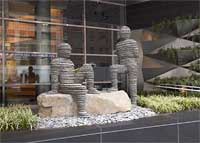 |
Boaz Vaadia
Asaf and Yo'ah
2001
Bronze, Bluestone, Boulder
78 x 100 x 100 inches
Time Warner Center,
New York, USA
|
|
Vaadia attended the Avni Art Institute in Tel Aviv, Israel. In 1975, aided by a grant from the America-Israel Cultural Foundation, he came to New York City. There Vaadia studied at the Pratt Institute and the Brooklyn Museum Art School. His decision to focus on producing art led him to a succesful career without obtaining a final degree.
Vaadia established his studio in SoHo just before a new community of working artists emerged. Like many young artists he struggled to make a living. While working in construction jobs on the side he discovered slate and bluestone as perfect materials for his art. Vaadia used these materials to make personal totems that evoked primal energies and ritual. In 1976 Vaadia had his first show at the Hundred Acres Gallery in SoHo. Ten years later, in 1986, he had his first figurative show at the OK Harris Gallery in SoHo. The entire show sold out in 3 hours.
Vaadia’s works grace prominent public spaces and private collections around the world, including the Time Warner Building, New York; the Museum of Modern Art, San Francisco; the Metropolitan Museum of Art, New York; the Israel Museum, Jerusalem; the Hakone Museum, Hakone and the private collection of Elton John.
Boaz Vaadia lives and works in Williamsburg, New York. His sculptures vary in price between $8,000 for a very small piece, to $300,000 for larger stone pieces with two figures.
Art Interview: You grew up in Israel, is that correct?
Boaz Vaadia: Yes, that's correct.
Art Interview: What was it like?
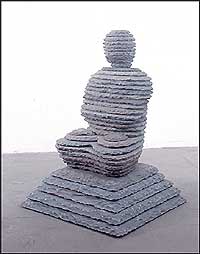 |
Boaz Vaadia
Ba'al-Zevuv
1999
Bluestone
50 x 35.5 x 35.5 inches
Private Collection Florida, USA
|
|
Boaz Vaadia: I grew up on a small farm in the center of Israel. It was a wonderful, wonderful, wonderful way of growing up. My parents had traveled the world and they were both very cultured. My father had an agricultural education so they made the decision to farm the land. One of the things they truly instilled in me was a love of Mother Earth in a very direct way. My father used to plow the land with a mule, and I used to walk behind him and he said he didn't like tractors, because tractors rape the land. My parents really loved the earth and they believed that's what the new Israel should be about. I found that very beautiful in my youth and this is still being explored within my work so many years later. There is an absolute connection to the way I grew up in Israel.
Art Interview: How is there a connection to the earth within your work?
Boaz Vaadia: There is a connection through the materials I work with and the environment that I work in.
One of the things that I was convinced of was that you could only find that kind of love for the land and the willingness to give your life defending it, in Israel. But what I found when I started traveling around the world was that this love is actually a universal feeling. Many different ethnic groups from very different countries have the exact same connection. I've talked with people from American Indians to Palestinian farmers and I’ve found that anybody who actually works the land and even people who don't, still in some way have that kind of connection to the earth.
Art Interview: Was your father always a farmer or did he have other businesses before the farm?
Boaz Vaadia: He was always a farmer.
Art Interview: Was your family a middle-class family?
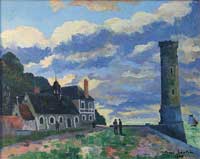 |
René Sautin
(1881-1968)
Vue d'Honfleur
1924
Oil on Canvas
54,5 x 64,5 cm
|
|
Boaz Vaadia: You know, it's funny - looking back, I think we didn’t have much money. But I never felt that we lacked food or money when I was growing up. I had a tremendous amount of love for my parents and they were a great support for me when I decided to spend my life working as an artist. My father had traveled before he became a farmer. He lived in Paris for seven years and worked there during the time that Paris was the world’s art center. He worked at a fruit and vegetable stand and gave fruit to René Sautin and all of the artists who were struggling at the time. Here’s a very entertaining story: Sautin wanted to give my father a painting of a dead chicken for helping him. But my father said "I don't need a dead chicken, what do I want with a dead chicken?" Later in life he said, "You see what happens, I should have taken that dead chicken, and I could send you to study art anywhere in the world!"
Art Interview: Did your father have any fears about you becoming an artist?
Boaz Vaadia: My parents were always supportive. I am very dyslexic and I had problems studying because of the disability, especially with reading and writing. So, it was pretty obvious that I was not going to go into the sciences or be an academic due to my handicap. In some ways dyslexia had something to do with my career choice.
I think my parents worried about my ability to make a living but they gave me full support to do whatever I wanted. I was actually very lucky because I always received recognition for my talent as a young man. I got a full grant in Israel from the America-Israel Cultural Foundation, which allowed me to study and work in New York. That gave me the capacity and financial support to do my work for two years in a loft in SoHo. My first show was within a year after arriving in New York, on West Broadway. I received a very positive response to my work.
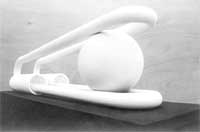 |
Boaz Vaadia
Untitled
1971
Painted Metal
16 x 48 x 14 inches
|
|
Art Interview: Did you study art in Israel before you went to New York?
Boaz Vaadia: I studied at the Avni Art Institute in Tel Aviv. It had a four-year program and I took 4 or 5 hours of classes there every evening. It was more of a studio setting but they had some academics. I actually started at the school at a very young age; I was accepted when I was about 14. Most of the students there attended after returning from the army, so there was a big age difference.
Art Interview: What kind of work were you doing while you were there?
Boaz Vaadia: I was working in a ceramics studio and studied with some teachers there. I had the keys to the school, so I was there every day, working. One thing I’ve consistently done during my career is work every day in my studio, regardless of what was scheduled. Even if I had a full-time job, I would still work 6 hours a day in my studio.
Art Interview: Did you leave Israel because of the grant?
Boaz Vaadia: In the early 70's you could feel the energy of the art center move from England to New York. I was very lucky because after I returned from the Army I was able to teach at the Avni Art Institute where I had studied. Then I got the grant and there were two places I was attracted to: I had thought about going to Cararra, Italy to work because of the stone and the history of stone carving you can find there. I was also interested in New York because of the stories that I had heard about what was happening in SoHo at the time. I had some friends in New York. So I allowed myself to go to where I thought the action was. I wanted to be exposed to all of those energies and juices that were going on at the time.
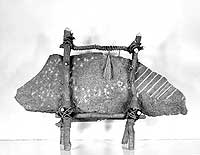 |
Boaz Vaadia
Untitled
1975
Stone, Wood, Fur, Leather
24 x 32 x 10 inches
|
|
Art Interview: This was in 1975?
Boaz Vaadia: Yes, I came to New York in 1975.
Art Interview: When you arrived you started studies at the Pratt Institute, is that correct?
Boaz Vaadia: That is correct. I came to the United States on a student visa and was accepted into the Pratt Institute. I studied there for one year, and had my first one-man show in SoHo. When some of my professors at the Institute asked me to introduce them to my dealer I realized there wasn’t much more that they could give me so I quit and didn’t get a degree there.
Art Interview: You don't have any degree?
Boaz Vaadia: I don't. The Avni Institute had a four-year program, but I never finished it. There were times when I was teaching that I would say to people, "Look, you can do the degree. But the degree is only a safety bracket; it's not something you need to be an artist. It's something that your parents might want you to have so you might be able to be a teacher.” I jumped into being an artist all the way, and I knew that's what I would do all of my life.
Art Interview: You had no fear of not being able to find a market?
Boaz Vaadia: Actually, when I made the decision to be an artist I never even imagined that I could make a living out it. When you're that young, you don't have the capacity to fear.
Art Interview: Did you have to work at part-time jobs or full-time jobs to support yourself in the beginning?
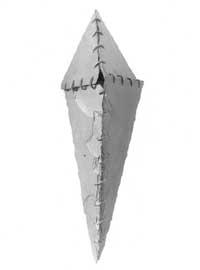 |
Boaz Vaadia
Untitled
1982
Slate Shingles, Leather
20 x 7 x 4.5 inches
|
|
Boaz Vaadia: Yes, I worked part time from 1979 to about 1982 as a contractor. I did all kinds of construction work. I was good with my hands and I could make just enough money in three months doing construction to spend the rest of the year in my studio. I totally believed I would live in poverty all my life. But it wasn't an issue. My decision was made.
As an artist you work in two parallel lines. The first line is the creative process, and what you do with that creative process, and then the second line is the artistic success; the commercial implications, and who-you-know implications, and all of the things that are a part of any kind of professional success. The creative aspects and the business aspects of an art career are almost schizophrenic. I manage to separate these worlds and wear my artist overalls and my business suits very well. But, "What is a success in art?", is a very interesting question. Is success in art commercial success? Is it having the capacity to stay creative and productive in your studio all your life? Or is success when people write about you everywhere? In my mind success is to have the capacity to explore in your studio and be creative in your studio on a constant basis. That's where success comes - the rest you really don't have much to do with.
One of the best things that have happened to me because of my success is that I will not do have to do sculptures unless I really want to do them. I tell people who want to commission work from me what I would do for the site and I tell them the particular scheme that I think would work there. I will not change that. Either they want it or they don’t. If they want something else, I tell them to find another artist. I will not do things that have already been done. If I feel I will not grow from the work, I won’t do it. The financial success absolutely allows me to be truer to my creative process. That isn't always the case with other artists. The power of the dollar is a mighty temptation.
Art Interview: After you went to the Pratt Institute you spent more time at the Brooklyn Museum Art School.
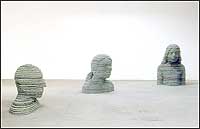 |
Boaz Vaadia
Instalation: Studio
(Meir, Rebecca, Sara)
2002
Bluestone
|
|
Boaz Vaadia: Yes, I only had a student visa, so I had to attend a school. Some teachers from the Brooklyn Museum Art School saw my work and said, “Why don't we give you a grant and a studio and you can be a student here”. So I got a Beeckman scholarship, (which paid for the tuition).
Art Interview: Was that something that you initiated or did it happen by chance?
Boaz Vaadia: It was by chance that one of the professors at Pratt was also teaching at Brooklyn Museum Art School. I went there because it didn't make any sense to stay at Pratt. Pratt had more academics than studio work. I also had a very big studio in SoHo.
Art Interview: How were you able to afford your studio?
Boaz Vaadia: At the time (1975) a 3,000 square foot loft rented for $500 a month. It was not very expensive at all.
Art Interview: Were you working while you were in New York?
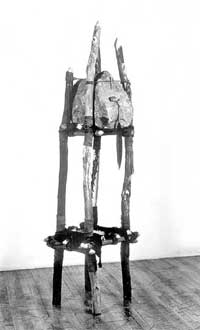 |
Boaz Vaadia
Untitled
1976
Stone, Wood, Fur, Leather
72 x 23 x 19 inches
|
|
Boaz Vaadia: No, I had the grant and it allowed me to pay for the studio for the first two years so I could concentrate on my work. Then I had my first show at the Hundred Acres Gallery, around 1976.
Art Interview: Was that show successful?
Boaz Vaadia: What do you call successful? Financially, I was not successful.
If you go to my website at www.vaadia.com you can look at my early work. I was continuing the self-exploration that I’d started in Israel. When you make the same sculpture in different materials it has a totally different feeling. That amazed me. During my Avni years I did a lot of experimental work based on that. Totally understanding the materials you work with is very, very important, because the materials have a tremendous amount of power in and of themselves. I did a lot of work at that time with stone, human hair and branches, which had a lot of primitive influence from the African fetish and things that I saw in nature. I was very interested in looking at primitive ceremonial art that I felt was transferring the knowledge of how materials connect to primal forces.
When I came to New York, I was of course amazed by the scale of the city, and felt a little out of place for about a week. I thought, “What is this? What am I going to do here?” But slowly I understood that an urban environment is not unnatural. The natural things that I experienced while growing up on the farm actually exist within the urban environment as well. All the materials were there, it was just much more concentrated. When I was young, I remember seeing pictures of trees so completely covered with birds that you couldn’t see the trees anymore. On some islands where birds nest there isn’t the space for even a pin to drop. I feel that cities are in some ways similar - we as creatures get together in this urban environment and we live like the birds on an island. That is how I can remain connected to the earth and work in this environment.
Art Interview: Did you have difficulty getting into galleries?
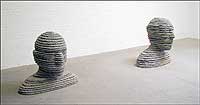 |
Boaz Vaadia
Instalation: Studio
(Meir and Raffael)
2002
Bluestone
|
|
Boaz Vaadia: No. I was very lucky that way. A colleague introduced me to Carlos Lemania. He actually was a dealer on West Broadway. And he came to my studio and he loved my work and he offered me a one-man show. But the gallery closed before my show. So he introduced me to the next dealer. I gave her my slides and she said, “Oh, thank you, very much. Let me see what I can do.” But she didn’t pay attention to them. She just laid them on her desk. Later a collector, Patrick Lennon, came by and just happened to pick up my slide sheet and said, “I want one of those.”. I was lucky that my slide sheet was right on top of her desk where someone would walk in and see it. It got her attention because Patrick Lennon was an important collector for her to get. He has a big museum now in California. The funny thing was he never did buy any of my work but she offered me a show. There was a lot of interest in my work and I received very good reviews but only a couple pieces sold. I’ve had very, very few rejections in my life. But I have had those too.
Art Interview: Have you done any monumental work?
Boaz Vaadia: Well, lets just say that my monumental work is not huge. The largest piece I've made of my current work is 12 feet. I did some larger pieces in my early abstract years that were 20 feet to 25 feet. But none of my work is huge. Most of my work is on a human scale because the experience is really happening between the piece and the viewer. The piece creates certain catalysts for the viewer to react to with his own connections and his own background. It cannot be dictated by any means, it becomes their presence and their experience.
Art Interview: So it was a choice to select that proportion, it wasn't a matter of finances that made you choose to do life-size pieces?
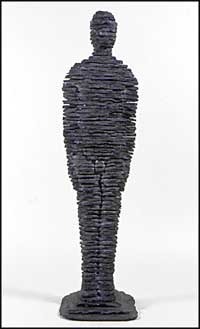 |
Boaz Vaadia
Adam
1985
Slate
17.5 x 6 x 4.5 inches
Private Collection - London, UK
|
|
Boaz Vaadia: I work now with layers of stone and I want to be true to the understanding of the materials that I’ve developed through many years. I’ve learned that there is a certain limitation to the size of the stone that I can get. When the stone is quarried machines do not cut it, it’s split at the rock’s naturally formed layer. Because they are split you can get only a certain size. The material limits you, and I believe that my style is a combination of understanding the material and its limitations and understanding the boundaries within which I have to work. You know, people don’t like the word “limitation” but the materials have certain boundaries that you have to work within. Because bluestone and slate are sedimentary rocks, the material is layered. This property of stone is what made me realize I should make my sculpture in the same layering process. It felt so right to me because not only is the stone layered but also as an artist my knowledge is layered and it makes me the person that I am. I became very excited when I discovered layering and I worked for a year-and-a-half, putting in very long hours in the studio. My first show with layered work was around 1986 and still to this day I know for a fact that really nobody else has ever worked that way. That’s pretty amazing because I started doing it because I understood something natural about the stone. I was pretty sure that by the time I’d get my first show out that people would say, “Oh, we saw someone else who does the same thing” because it is based on a very, very simple realization about how to work with the material. It’s a partnership between the material and myself. There is an understanding that I imply within the work and I’m very consistent about it. When I place stone on top of stone everything has to be totally balanced with no reinforcement. Again, I am paying great respect to the natural force of gravity.
Art Interview: Let me understand this correctly, you’ll take slabs of bluestone and simply balance them on top of each other without reinforcement?
Boaz Vaadia: What I do is actually carve separate stones and layer them on top of each other, layer by layer. I carve the bottom layer, then carve the next layer and then carve the next layer. When the piece is finished, it’s totally balanced. Then for safety and permanency, I’ll secure them by drilling a system of holes, which are bolted with a stainless steel rod. I can’t allow hundreds of pounds to be loose like that. If someone was to bump into it, they could be seriously hurt. So I secure them for safety.
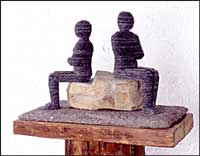 |
Boaz Vaadia
Amoq and Zadoq
1990
Slate, Bluestone, Boulder
20 x 29.5 x 17 inches
Private Collection - Illinois, USA
|
|
Art Interview: When did you have your initiation into bluestone?
Boaz Vaadia: Almost immediately when I move into SoHo in 1975. At my first show in Hundred Acres Gallery I showed work that continued to explore the influence of primitive art using curbstones and bluestone. I built structures and carved lines into them that were related maybe to cave carving or holy places. I also included a kind of offering by putting feathers and pebbles on top of the work.
In 1975 they were doing a lot of construction work in New York and every time that they ripped up the curbstones, they would throw them away and they would replace them with metal reinforced cement curbs. So I used to go to all of those places and pick up all these materials for free.
Art Interview: Now how did you carry them? They’re very heavy.
Boaz Vaadia: They are heavy, but I transferred pieces that were manageable and I had some friends that helped me. Originally I had a one of those supermarket-shopping carts that I’d to go to all the sites with. I would fill it up with all the fragments. The biggest fragment that I could take was maybe 500 pounds. And I would work with those pieces. Later I bought a hand truck.
Art Interview: Did you keep everything in your studio?
Boaz Vaadia: Yes.
Art Interview: How did you transport the final sculptures to the galleries?
Boaz Vaadia: From ‘75 to ’89 I had a studio in SoHo on the seventh floor and it had a very big freight elevator. Things could be loaded onto the freight elevator with hand trucks and moved up and down from my studio.
Art Interview: Did you lift these things with cranes?
Boaz Vaadia: Not at the time because they were really being done in layers. Each layer by itself can be up to 200 pounds but people can still lift them. So you can transport a sculpture that weighs 5,000 pounds in sections. I delivered them piece-by-piece and reinstalled them at the gallery.
I’ve had three studios in my entire life. The first was in the village where I grew up in Israel. I had converted a chicken coop into my first studio. Then when I came to New York, I moved into a studio in SoHo. From there I moved to the studio that I have now, which is in Williamsburg. It is a ground floor space with 4,000 square feet. When I moved to my studio in Williamsburg I introduced glacier boulders into my work. Those are very, very heavy and require heavy equipment to be transported.
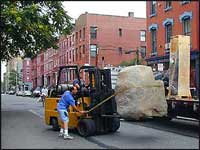 |
Boaz Vaadia
The Shipping of Zadoq and Shim'on
August 11th, 2000
Out in front of the studio, a shipping crew is contracted to load and haul the piece. The boulder here weighs about 5 tons!
|
|
The introduction of glacier boulders into my work happened in a natural way. While I was still in SoHo I had been studying rounded pebbles. Then I found a few small glacier boulders that reminded me of these pebbles so I picked them up with my hand truck and took them back to my studio. When I bought my studio in Williamsburg they were putting new sewer and water lines in. They were digging the streets and pulling out these incredible boulders and putting them on the sidewalk right in front of my building. I actually had to postpone my moving into the studio because the boulders were blocking the way. But I felt like a kid on the beach seeing all those big boulders. So I went up to workers and I said to this guy, “Listen, what are you doing with those?” And he said, “If you want them, they’re yours.” And he jokingly said, “Come and pick them up.” So I said, “Let me figure it out.” I discovered a used forklift dealer five blocks from there, so I went over and I bought a forklift. I picked up all those boulders and moved them into my empty studio. I put them all around and I said to myself, “What the hell are you doing to yourself? You have all these boulders now, what you going to do with them?” But one day it started to rain and I said to the construction guys, “You know, why don’t you come over and have lunch in my studio to stay out of the rain?” When they came in with their lunch boxes each one of them chose a stone to lean on or sit on. It suddenly occurred to me what I would do with the boulders. And the reason I liked it was because it reminded me of those moments when I was in nature, taking a hike and there was a certain boulder or stone that attracted me to sit down. It almost directed me how to sit. Why do particular boulders attract us to sit down or to lean against them? What is it about certain pebbles that attract us when we go on the beach? Why do we want to pick them up? We bring them home and we put them on the windowsill and we don’t know why we did it. This, to me, is an example of a primal connection that we all have. It was what I had been exploring during my whole career.
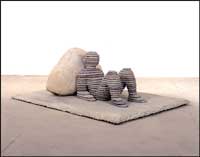 |
Boaz Vaadia
Gamli'el
1994
Slate, Bluestone, Boulder
30 x 85 x 61 inches
Private Collection - New York, USA
|
|
I’ve been using boulders in my work quite a bit. Williamsburg is booming right now so I still have huge amounts of boulders that I can pick up from construction sites within 20 blocks of my studio. I get phone calls all the time from construction sites that they have boulders.
Art Interview: Are you paying for your materials?
Boaz Vaadia: The bluestone I buy. Of course, I can pick up a few at construction sites but there are not very many stone sidewalks being dug up anymore. So, I buy it from the same quarries that the city uses for its supply of bluestone. I don’t pay for the boulders, but I have to pay for their transportation. I have a very, very good relationship with all the heavy equipment operators in Williamsburg.
Actually, after that first experience, when I tried to get more boulders nobody would talk to me. I was at this construction site, I said, “I need this boulder,” and they said, “Get off the site!” So, the next day I went back to the site with a case of scotch and gave a bottle to each guy on the heavy equipment. I told them, “I love what you doing. You guys are great,” and then I left. The next day when I came back one of the guys said, “Hi, how are you?” so I asked, “What are you doing with this boulder?” He said, “You know, we are really just throwing it away.” Then I asked, “Can I have it?” and I pulled out a roll of hundred-dollar bills. The boulders found their way to my studio. The real cost is not the boulder; it is moving it. Every time you have to move a boulder, you need to operate heavy equipment. Some of it I can do myself but I often have to hire a crane to bring them in.
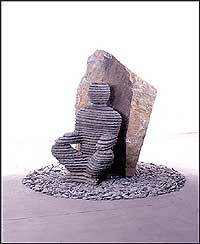 |
Boaz Vaadia
Eli'ezer
1988
Bluestone, Boulder
30 x 85 x 61 inches
Private Collection - California, USA
|
|
Art Interview: Have you ever had any accidents working with stone?
Boaz Vaadia: I had a major accident a year ago that almost got me killed.
Art Interview: How did that happen?
Boaz Vaadia: A boulder slipped free when we were moving it and my leg was crushed. I’m actually still healing from that but I was back in the studio within a week after I left the hospital. The surgery motivated me to keep working but it took a tremendous amount of commitment to meet my deadlines. But I always deliver on time. So I was kept very busy and it was great for my healing process.
Art Interview: When you were young and still living in Israel, did you imagine that you would have to deal with transporting huge stones?
Boaz Vaadia: No, not at all. It’s all related to the scale and the space you work in. Those things have an impact on your work. People have asked me, “Would you still be an artist if you didn’t have the space?” “Of course” I’d say. “I’d do something that relates to the space that I’d be working in.”
The question is how can I remain respectful of my materials and find my own style? A lot of people relate to my work because they see is a connection to ancient stonework, such as sculptures from the Egyptians or the Incas. When you look at Greek and Roman stone sculptures you basically find only torsos. You don’t find many full pieces. What I feel happened is that the sculptors pushed the materials to a point that wasn’t appropriate for that material. They were doing things in marble that actually should have been done in bronze. I really believe that that’s why Michelangelo left his slave series unfinished. He basically stopped when he felt that he didn’t want to push the stone any further.
There is definitely a feeling you get when you have found the right spot. I find that a lot of time artists push the materials to serve whatever ideas they have. I’m not saying that that is bad. It’s okay. You can do whatever you want. But it’s not what I do. I place an importance in the natural properties of the material and try to respect those values.
Art Interview: So, you are respecting the natural boundaries of the material?
Boaz Vaadia: Yes, but although I work with boundaries, one of the beautiful things about art is that there are no boundaries. I think that each individual can explore and have a totally unique way of seeing things.
Art Interview: So, you think creativity has no boundaries?
Boaz Vaadia: Yes, creativity has no boundaries but each particular artist does. Every artist that I respect managed to understand his boundaries and learned to work within them to create his own style.
Art Interview: Did you have role models that affected the choices that you’ve made?
Boaz Vaadia: I did. I can say that I was tremendously influenced from ancient and primitive art. During the years I studied in Israel, Michelangelo and Rodin influenced me. Henry Moore definitely influenced my work. The way Noguchi worked with stone makes me think that he had the same deep understanding about stone that I feel. I love Giacometti’s work. He absolutely understood the boundaries that he worked within and his work is very much what it is because of his understanding of those boundaries. I use the word “boundary” with him because for me that is a term of respect. I use the word “limitation” with me because I recognize that those boundaries in some ways are limiting. But they are what eventually create each individual artist. So you can call them “boundaries” or you can call them “limitation.” But it is that scope which we work with.
Art Interview: Do you feel that stone has some type of primal spirit to it?
Boaz Vaadia: Yes. Stone definitely arouses primal connections to the earth for me. There has been a tremendous amount of history between the human race and stone. Stone was a part of our evolution.
One of the things that attracted me to bluestone and slate is that through our evolution we recognized the value of its layering properties. We split the rock to create flooring and used it to create roofs over our heads. One of our most basic needs is to create a shelter. Those things have left a residue within the human race.I believe that stone is a material that has the capacity to touch the deep primal connections somewhere within us. At least that’s what it does with me and so I follow that feeling. I don’t think that it will ever be the same thing with plastic. I’m bringing up plastic because plastic is a material that is often used in contemporary art and it has its own values.But it doesn’t give the same inherent deep feelings that you get from stone.There are moments when I work with stone that it really humbles me. I suddenly understand I’m working with a boulder whose shape was created thousands and thousands of years ago by glaciers. It was formed in the northern plains of Canada and moved to the New York Bay by the glaciers. I am dealing with a material that is millions of years old. What are my hundred years of life compared to it? They are nothing. My lifetime is like a single second compared to the lifetime of the stone. When I work with the boulders I feel that they are the bone structure of the earth. It’s very powerful to me.
I work with roof shingles that were once the roofs of places of worship. Very few people know it but there is still that layer of energy that exists within my work. The challenge and my aims are to be true to that understanding that I have -- to really be truthful to it. I try not to allow the pulls of the market or the pulls of the ego dictate what I do.
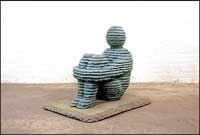 |
Boaz Vaadia
Pashhur ( Ed. of 5 + 1 A.P )
1993
Bronze, Bluestone
32 x 40 x 28 inches |
|
Art Interview: Have you ever been tempted to change things because of the market or because your ego?
Boaz Vaadia: One of the ways that I changed was by producing bronze sculptures that allowed me to stay true to my artistic beliefs and enabled me to exhibit the work in many more places, and therefore reach a much wider audience. When you cast bronze it allows you to create and sell editions, so much more work can be done than if I were working only with stone. I create bronze castings from my stonework. I do editions of five and one artist proof. And on the small pieces from slate I do additions of seven and two artist proofs. So, I have found something within the tradition of sculpture that allows me to improve my commercial success by giving me the capacity to make more work for sale.
Art Interview: How do you produce the molds when you’re casting off of such a complex stone piece?
Boaz Vaadia: I use the lost wax method. This is something I know how to do very well because I used to do it for other artists to support myself. I pour a rubber compound on the sculpture, let it dry and then create a shell from a hard material like polyester or plaster on top of it to maintain the shape. Then I open it up and cast wax into the rubber mould. When I take the wax out, I finish the wax to be exactly the way I want it. And I send the wax sculpture to the foundry. They dip it in ceramic to make a shell, which is then burned to melt the wax away. Then hot molten bronze is poured into the ceramic shell to take the shape of the wax. When the ceramic is broken away, you have the bronze piece. At that point I select the particular patina that I want and finish it. One of the things that I always do is add stone to every bronze piece. I may carve a bluestone base or add a glacier boulder to it. I don’t cast the boulder in bronze. So I have to find different boulders to fit each edition.
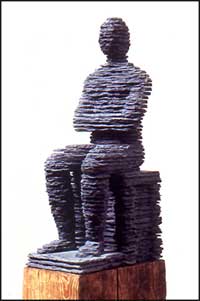 |
Boaz Vaadia
Joab
1986
Slate
16.5 x 5.5 x 8 inches
Private Collection - Washington, D.C., USA
|
|
In the ‘80s I had a three-year waiting list for my work and I tried to bring some people from Carrarra to help me with production, but I wasn’t happy with anything that anybody else did. They weren’t able to reproduce the quality that I wanted or the way I carve stone and I couldn’t transfer my feeling for the stone to them. So having carving assistants failed.
I basically made a decision at that time to raise my prices quite a bit. I dropped my waiting list to a year and decided to work with only one to two assistants. My assistant might cut a surface, but I still do all the carving on every single piece. If I could find someone to do a carving on a base the way I like it, I would do it. I wish I could, but I just don’t. I’m a perfectionist about every piece I make.
Boaz Vaadia: It's funny, I've been in the business a long time and I have a lot of very successful galleries representing my work, but I feel I am still a very young artist. I'm definitely a sculptor to my bones. I have found that the people who buy sculptures actually buy because they have a love and a major commitment to sculpture. They are not exactly the same type of collectors who buy paintings just for the investment.
Art Interview: Do you sell primarily to individual collectors or corporations?
Boaz Vaadia: I actually sell across the line. All of my sales are done through galleries, so sometimes I don’t know where the pieces are going. The galleries sell the work to their clients and I let them handle all those things.
Art Interview: How do you maintain a unified cost throughout the galleries?
Boaz Vaadia: I have to make sure my prices are the same no matter what gallery the work is shown in. I don't want to have collectors traveling between galleries and upsetting my relationship with them. So, I control all the prices. My prices are based on sales. If I sell everything and I have a waiting list, then I raise my prices. The price is truly based on the demand of the market. I try to keep my prices slightly lower than what some of my galleries would like. It's funny, because you can see how some galleries want to push it up, and some galleries want to leave it like it is. The galleries that sell pieces for a few hundred thousand dollars apiece want to raise my prices and those galleries that sell pieces for less want to leave the prices where they are because I'm the most expensive artist that they have. Each of them are basing their prices on their clients. So, I look at the demand for my work and the wide range of representatives that I have in order to find a price that is suitable for everyone involved. I also have consignment agreements that limit the ability of my galleries to give discounts. They can only give a certain range of a discount.
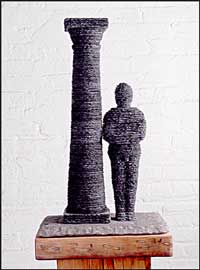 |
Boaz Vaadia
Amasya
1992
Slate, Bluestone
26 x 16 x 11.25 inches
Private Collection - New York, USA
|
|
Art Interview: I assume the galleries take a 50% markup. Is that correct?
Boaz Vaadia: Well, no. I'm making more than that.
Art Interview: Why are you able to demand a higher percent? Is this because of your name?
Boaz Vaadia: Technically, yes. What happened was I worked with a central gallery and they gave a percentage to other galleries. When I moved out of the central gallery I started working directly with all of the other galleries and I kept the percentage that the central gallery received so the galleries would not be able to compete with each other. That's the business part of the art world and I actually manage that very well. I've been very lucky that way. But I'm also very much aware of what I have. I grew up on a farm and on a farm when you have a good milking cow, you feed it well; when the milk is dry you send it to the butcher. I am still a milking cow.
Art Interview: How much are your pieces selling for now?
Boaz Vaadia: Small slate pieces sell for about $35,000. Larger stone pieces with two figures sell for between $250,000 and $300,000. The bronze pieces vary between $8,000 for a very small piece to about $160,000 for life-sized pieces.
Art Interview: Did your prices rise gradually?
Boaz Vaadia: Very gradually. Usually people raise their prices as the editions are sold. I don’t. I raise my prices when I see that I cannot produce enough. And actually I sometimes don’t even do that. Right now as far as the figurative stone pieces are concerned I only have one life-sized piece and three small slate pieces left available and that’s it.
Art Interview: Is there a secondary market for your work?
Boaz Vaadia: People are generally holding on to my work. My work goes on the resale market when estates are sold more than from living people selling off parts of their collection. But there are definitely sales in the secondary market because I get phone calls from galleries that say, “Oh, we just got this piece. What would the value be of a similar piece?” So I know they’re selling but not at auction. I had one situation when a big collector sold his entire collection. And he called me and said; “We’re keeping your pieces because we want them for our children.” Later they called me back and they said, “We have three big pieces of yours and we don’t have a place to put them.” I said, “This museum would love to have it. Why don’t you give it to them on loan?” So they basically gave them on loan to museums until their children are able to pick them up. But you don’t have control over your work when it’s on the market.
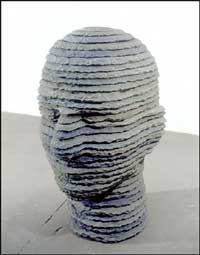 |
Boaz Vaadia
TAI
2003
Bluestone
53 x 33 x 42 inches
|
|
Art Interview: What are your plans for the future?
Boaz Vaadia: During the last three years I’ve been working on a new body of work that I’m very excited about. I’m using layering to make portraits. It’s a wonderful experience going back to the portrait. The challenge with this is that I’ve selected something that’s been done for hundreds of years. Most of the time artists achieve a likeness through concentrating on the detailed features of a person. But because of the material I use and the way that I use it I cannot produce details like that. This forces me to create portraiture from a completely different point of view than what is traditionally used. It’s a very, very interesting challenge. I make a classic clay portrait a little larger than half-life size. Then I cast it in plaster and I make lines on it as reference points. Then I reproduce it in slate. If the slate piece is successful I make a four or five feet high version in bluestone
Art Interview: What tools do you use to form the bluestone?
Boaz Vaadia: A hammer and a chisel. That’s it. A lot of people use earplugs but I don’t because I find that I lose the connection to the stone if I can’t hear the sounds of the chiseling. Somehow my body translates it into a tremendous amount of information. It’s a very physical experience. The sound tells you what to do. It’s not done intellectually. If I try to understand intellectually it doesn’t work. My body knows and understands it so much better than my mind. So I allow it to be that way because as soon as I bring the action up to my mind, it doesn’t work as well.
Art Interview: How long does it take to produce a portrait?
Boaz Vaadia: It takes about two and a half months to make a large head. To produce a two-figure sculpture it takes about five months. Four or five months.
Art Interview: Do you work on more than one piece at a time?
Boaz Vaadia: I work on several bronzes all the time. But I don’t produce huge amount of new stonework every year. When the sculptures return from the foundries, I work on the boulders.
Art Interview: How many pieces are you creating a year?
Boaz Vaadia: It varies from year to year depending on the size of the pieces. But in my best years I would produce between six to eight pieces. Last year I finished four pieces; two commissions and two stone pieces. But on the other hand I’m producing several bronzes from the stonework. While they’re in the foundry, I work on the other work. I just finished a commission that’s going down to Florida. So, I try to balance the whole thing.
This oral history transcript is the result of a tape-recorded interview with Boaz Vaadia on November 11, 2005. The interview took place over the telephone between Berlin, Germany, and New York, New York, USA and was conducted by Brendan Davis for Art Interview Online Magazine.
Download this article as a printer-friendly archived pdf file.
|